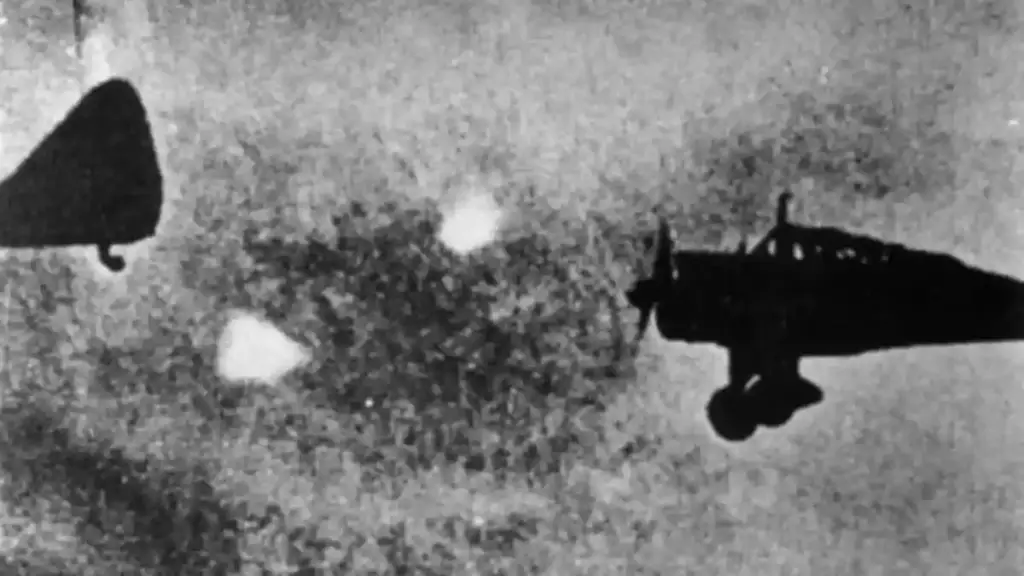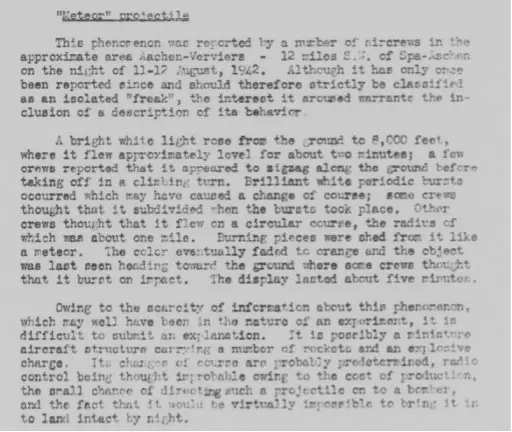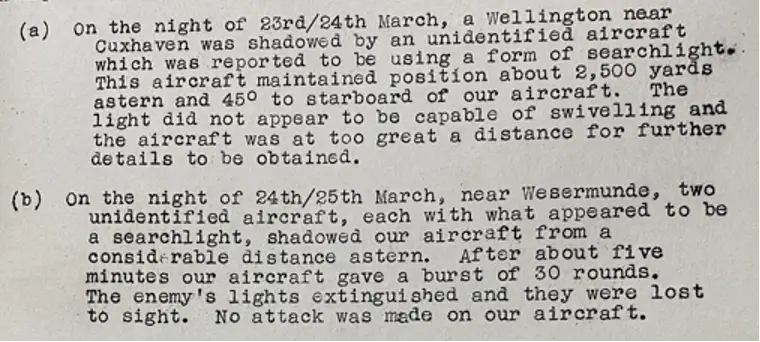
Although they may not have been called “Foo Fighters,” the members of the Royal Air Force spotted and reported strange objects flying over Europe for about two years before the American pilots who made the phenomenon famous named them.
One of the first reported sightings happened on November 28, 1942, during a raid on a Turin engine works. A Lancaster bomber from RAF Syerston was flying over northern Italy when it spotted a massive torpedo-shaped object. According to the report submitted by the crew, the object was about 200-300 feet long.
The objects, which were flying at speeds of around 500 mph, were equipped with four red lights that were spaced along their body. They didn’t appear like exhaust flames.
The report stated that the massive object was spotted twice, the first time around 11,000 feet and the second time around five minutes later as it flew along a valley in the Alps. The pilot who spotted it said that similar objects were flying north of Amsterdam around three months earlier. No.5 Group’s commander, Air Vice Marshal Alec Coryton, received the report and sent it to Bomber Command HQ for further analysis.

The report was sent by the crew of a Lancaster bomber. Despite the usual jokes about their experience, the members of the crew refused to be shaken by the incident.
The aircraft that was involved in the incident was an Avro Lancaster Mk.II bomber from No. 61 Squadron. It was flying over northern Italy on November 28, 1942.
The report was sent to No.5 Group’s HQ. It was from the commander of RAF Syerston. The strange object was spotted by the crew of the aircraft on November 28.
In December 1942, it is highly unlikely that the Germans built an airship that flew slowly and lumbered across the Italian Alps. In any case, the reported object’s speed was way over that of an operational machine at that time. Its size also exceeded that of any conventional aircraft that Germany had successfully tested by the end of that year.
The strange objects flying over northern Italy at that time remain unexplained. In February 1944, another group of bomber crews spotted two cigar-shaped objects near Koblenz and an over Aachen. These objects were referred to in reports submitted by Bomber Command.
UFO reports about cigar-shaped objects became a common feature during the 1950s, 1960s, and 1970s. These types of objects could also be described in similar fashion to the Tic-Tacs of the modern era.
According to intelligence documents held in London’s National Archives, the objects were spotted by RAF bombers as early as August 1942. The objects were described as rocket-like and appeared to be flying toward the aircraft. Details about the incident were presented in an operational research report released by Bomber Command.
One of the objects was described as a bright white light that rose from the ground and flew at an altitude of 8,000 feet for around two minutes. Some of the crew members noted that it appeared to have a zig-zag pattern before it changed course.
The incident occurred around six months before Germany started testing its first surface-to-air missiles. This was well outside the testing facilities at Peenemnde, which were located on the Baltic coast.
In November 1944, American pilots began referring to the UFOs as “Foo Fighters.” By then, Bomber Command’s Operational Research Section had started to investigate what was happening in the skies over Europe.
The pilots believed that the objects were moving fast and that no aircraft was spotted. They also noted that the objects did not appear to have fire.
Although the incidents in August and November 1942 were the first reported sightings of UFOs in Europe, other strange sightings were also reported in the region. One of these was in March 1942, when a Polish pilot reported seeing an orange object flying toward his plane as it was returning from a raid on Essen.
After the war, Sobiski went to Canada. In the 1960s, he talked about the incident and revealed that he ordered his tail gunner to open fire on the UFO. However, he noted that the object was not able to withstand the machine-gun fire.
According to the pilot, the bullets in the object stayed put as they flew toward his plane for around two minutes. After that, the object changed its direction and flew toward the plane’s port side. It stayed there for about 200 yards.
The nose turret gunner of the plane, Krzysztof Grabowski, then started shooting at what he thought was a German fighter plane. Unfortunately, no damage was reported on the object. However, the object changed its direction and moved ahead of the plane. Grabowski continued firing at the UFO for a second time.
After a couple of minutes, the object disappeared as it flew over occupied Europe. It shot off at a 45 degree angle and disappeared.
Upon returning to base, Sobiski was informed that another plane had also spotted the UFO. However, no official report about the incident was made. The mission records of the squadron did not contain a record of the incident.
Further research has revealed that similar sightings were also reported by Allied planes as early as March 1940. These incidents occurred just months before the Luftwaffe, which was Germany’s air force, started operating its first night-fighting units. Reports about sightings of what were described as glowing objects flying in the sky continued to be made throughout 1942.
During the war, the RAF experimented with developing airborne searchlights. However, their operational deployment was unsuccessful and troublesome. Germany, on the other hand, did not try to develop a similar system. Instead, they relied on radar technology to develop their ground-based searchlight batteries and anti-aircraft guns.
It’s not clear what the objects were, or if they were lights that were attached to an aircraft.
In a report released in 1940, an unidentified plane was described as carrying searchlights. However, since Germany did not try to develop these systems, the exact nature of the object was not known.
During the Second World War, the crew members of bomber planes were not exactly sure what they were seeing. Germany also did not deploy surface-to-air missiles during the war. Although they experimented with this technology, they were never able to produce operational systems.
In December 1944, Germany’s first operational jet fighters took off at night. However, until the end of the war, they were still mainly stationed in Berlin. They were not able to account for the numerous sightings that occurred throughout that year.
Over the years, researchers have generally accepted the notion that Kenneth Arnold’s encounter with an unidentified flying object in the Pacific Northwest in 1947 was the beginning of the modern UFO phenomenon. However, it’s becoming more clear that other similar sightings were also reported by aircrew members around five years before his encounter with the object.



Leave a Reply